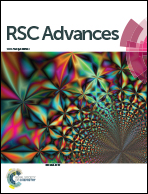Acidic ionic liquid modified silica gel for adsorption and separation of bovine serum albumin (BSA)†
Abstract
In this work, silica gel (SiO2) was modified with an acidic ionic liquid (Im+·HSO4−) and the product was characterized using infrared spectroscopy, thermogravimetric analysis and elemental measurement. Then it was used in the adsorption of bovine serum albumin (BSA) for the first time. Then the influences of initial concentration, temperature, solid–liquid ratio and pH were investigated. These studies showed that the adsorption equilibrium data fit well with the Langmuir model and the pseudo-second-order model could be used to describe the adsorption kinetics more accurately. The major thermodynamic parameters including the change of enthalpy, entropy and Gibbs free energy indicated that the adsorption was an exothermic and spontaneous process, which was controlled by chemical and physical interactions. The mechanism was also investigated using characterization and comparative experiments. All of the proteins tested reached their maximum adsorbed amount on SiO2·Im+·HSO4− when the pH was around their isoelectric point, and the adsorption capacity was lowered with the increase of protein volume. After the desorption using an aqueous solution of sodium chloride, the SiO2·Im+·HSO4− could be recycled for several times. Finally, the selective adsorption of BSA and bovine hemoglobin from cow blood could be successfully realized under the appropriate pH conditions. This study is aimed to provide a preparative method for the selective adsorption and separation of BSA with a supported ionic liquid. Furthermore, it is expected to enrich the separation materials of proteins and extend the potential functions of ionic liquids.


 Please wait while we load your content...
Please wait while we load your content...